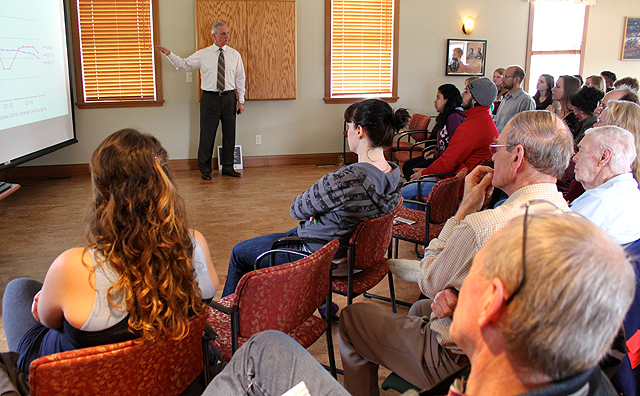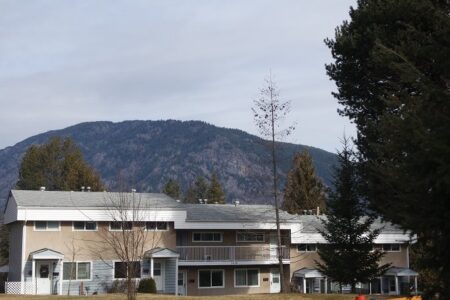Helmut Pastrick Speaks at Mir Centre — Declining CDN Dollar and Oil Prices Predicted
Helmut Pastrick, Chief Economist for BC’s Central 1 Credit Union, was in the Castlegar Friday at Selkirk College’s Mir Centre for Peace to discuss current economic trends and how they affect the Kootenay region.
The event, sponsored by the Columbia Basin Rural Development Institute, was well attended by an eclectic crowd of Selkirk College economics students, retirees, local business owners and Shambhala Music Festival’s manager of finance.
“The financial crisis of 2008/09 was the most profound economic event since the depression of the 1930’s,” began Pastrick to an attentive crowd during the 90-minute presentation.
“The recovery has been slow, and today’s economic landscape remains affected by that severe downturn.”
Pastrick said in the global flows of finance and power, the wellbeing of the Kootenay economy depends largely on the financial climate of powerhouses such as China and the USA.
China’s current manufacturing slowdown may be a contributing factor to a small increase in the unemployment rate in the Kootenay region (Source: Bloomberg and Statistics Canada).
According to Pastrick’s predictions, the Canadian dollar will continue to decline throughout 2015, and could dip as low as 65 cents CAD to the US dollar.
“This is not necessarily bad news,” said Pastrick. “A low dollar encourages tourism and an increase in Canada’s export economy.”
As to the unexpected plunge in oil prices during the past six months, Pastrick predicts the oversupply of oil to last well into 2015.
“While this is a net positive to consumers”, stated Pastrick, “persistent low oil prices could make some Canadian production uneconomical”.
Pastrick illustrated this statement with a graph showing market oil prices, which currently stand at US$60 per barrel of crude oil.
While Saudi Arabia’s full cycle costs per barrel stand at US$20, Canada’s oil sands are currently the costliest oil producers in the world, with each barrel costing Canadian companies US$80.
If oil prices stay at US$60 per barrel, some Canadian oil sands will be running at an extreme deficit.
“I say someCanadian oil sands,” clarified Pastrick, “because established oil companies such as Suncor do not carry the same costs as smaller, younger oil production companies.
“Suncor and other oil giants will finish the projects they have started but will not currently expand production. Other smaller oil producers may struggle to sustain a profit.”
The current global oversupply of oil can be attributed to an increase in fracking and horizontal drilling in the abundant shale reserves of China, and a November 2014 decision by OPEC (Organization of the Petroleum Exporting Countries) to not cut production due to lower oil prices.
Declining oil prices may correlate to a declining trend since 2010 in small business counts for the Kootenay region.
However, housing sales in the Kootenays are turning up after a mid-2014 slowdown, and mortgage rates are predicted to continue to drop.
Pastrick admitted that Kootenay statistics might not necessarily reflect reality, as census sample sizes are characteristically small (250 households out of 65,000). Also, the non-response rate to polls stands at around 20 percent, which Pastrick described as “ideologically driven”.
Pastrick concluded his lecture by stating that the Kootenay region has the potential for expansion in the tourism, forestry, and coal industries.

























Comments